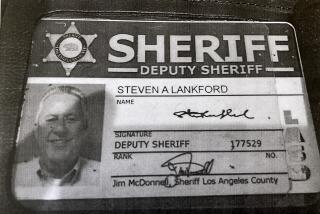Troubled Wang Decides to File for Chapter 11 : Technology: The once-successful computer firm is $550 million in debt. It failed to keep pace with change.
- Share via
BOSTON — Wang Laboratories Inc., a once-mighty computer company founded as one man’s dream 41 years ago, tumbled into bankruptcy court Tuesday after failing to keep pace with a rapidly changing market.
The move will mean more job losses for the struggling New England economy, and also served as a reminder that no computer company is safe from financial distress, observers said.
“Everyone is at risk in a market where technology changes as dramatically as it does today,” said Thomas Willmott, an analyst with Aberdeen Group in Boston.
Wang Chairman Richard W. Miller, hired three years ago by founder An Wang to rescue the company, said the firm had been on the brink of bankruptcy since his arrival.
“It was a painful decision for the company and one that we have tried for years to avoid,” he said. “But it was a necessary step in order to help our efforts to turn the company around.”
Miller said Wang had no alternative but to seek Chapter 11 protection because the cost of restructuring the past few years drained away cash needed to meet debt obligations. The company said it now owes about $550 million.
During its bankruptcy reorganization, Wang plans to cut about 5,000 jobs, including 1,500 in Massachusetts.
The expected reductions would follow thousands of earlier job cuts Wang made to try to remain solvent. With losses exceeding $1.5 billion, the company has shrunk its work force from a high of 31,500 to 13,000.
The bankruptcy case was no surprise. Wang had delayed release of its fourth-quarter results, raising speculation that a Chapter 11 filing was imminent.
Wang disclosed its results Tuesday. It lost $116 million, or 68 cents a share, in the quarter ended June 30, compared to a loss of $315 million, or $1.88, in the 1991 period. Revenue in the latest quarter was $474 million, down from $492 million a year earlier.
Miller said he expects Wang to emerge from bankruptcy as a smaller company, focusing more on software and services and cutting back sharply on manufacturing. He predicted that the company’s basic business will remain intact.
However, some analysts are skeptical.
George Colony, president of Forrester Research Inc. in Cambridge, Mass., said he expects Wang Labs to essentially disappear. He predicted that the company will be sold off piece by piece.
“I think the only way they can come out (of Chapter 11) would be a breakup of some sort,” he said.
Whatever the outcome, some analysts see Wang’s Chapter 11 filing as a sad chapter in an American success story.
“It isn’t just a company going bankrupt. It’s dreams going bankrupt too,” said Ann Palermo, an analyst with International Data Corp. in Framingham.
The dream was held by An Wang, a Harvard-educated Chinese immigrant who founded the company in 1951 above a Boston hardware store. His company soared, first with a desktop calculator and then with a word processor that revolutionized the office.
But observers say An Wang refused to see the threat from personal computers. After PCs arrived in the 1980s, they scuttled the market for Wang’s word processors.
That left Wang Labs with a line of mid-size minicomputers that used proprietary technology that itself would eventually lose favor as the market shifted toward industrywide standards.
An Wang made other mistakes. Like other executives in the 1970s and ‘80s, he used millions of dollars in debt to fund his company’s expansion. Wang’s debt burden, although substantially reduced in recent years, contributed to the company’s bankruptcy filing.
The company’s troubles prompted Wang to fire his eldest son, Frederick, as president in August, 1989, replacing him with Miller, a former General Electric Co. executive.
Even then, An Wang was drawing up petitions to file for bankruptcy protection, Miller said.
Miller, who became chairman in 1990 after An Wang died, made a bold gamble to save the company, creating an alliance last year with onetime archenemy International Business Machines Corp.
Under that deal, Wang is selling IBM computers while tailoring software to the machines.
Miller won both praise and criticism for the alliance. On one hand, analysts say, he was taking a painful but necessary step, but the alliance may have accelerated defections within Wang’s customer base.
“They always had a hard time showing why you should buy it from Wang if you could buy the same computers from IBM,” Colony said.
Added Willmott: “In the same deal were the seeds of brilliance and seeds of disaster.”
But Miller said Wang is sticking with the alliance, which he says is the key to the company’s future.
Wang’s stock fell 25 cents to 50 cents a share on the American Stock Exchange.
Wang’s History
Here is a brief history of Wang Laboratories Inc., which has filed for bankruptcy court protection:
* 1951: An Wang launches Wang Laboratories with $600 cash. The company’s early products were based on a Wang invention in the 1940s of a way to store data in a magnetic core.
* 1964: Wang Laboratories introduces the desktop calculator, spurring huge growth.
* 1967: Wang goes public at $12.50 a share. By the close of the first day’s trading, the stock is at $40.50 a share.
* 1976: Wang revolutionizes the office with the electronic word processor. Sales soar.
* 1982: Revenue hits $1.1 billion.
* 1984: Wang enjoys its last strong year of profitability, earning $210 million on revenue of $2.1 billion.
* 1985: Profit slides to $15.5 million, and 1,600 jobs are eliminated.
* 1986: Frederick Wang, An Wang’s eldest son, becomes company president and chief operating officer at age 36. An Wang remains chief executive officer. More than 2,000 jobs are eliminated.
* 1987: Wang Laboratories reports a $71-million loss.
* 1988: Revenue hits $3 billion, a level the company never reaches again.
* 1989: Wang Laboratories suspends payments on $209 million in debt and announces debt restructuring. The company loses $424 million. An Wang ousts son as president. Richard Miller takes over and begins slashing the firm’s work force and its debt.
* 1990: An Wang dies of cancer at the age of 70. Miller becomes chairman. The company loses $716 million.
* 1991: IBM and Wang Laboratories announce an alliance under which Wang will sell IBM computers and provide software to support them. Wang loses $386 million.
* Aug. 18, 1992: Wang files for protection under Chapter 11 of the federal bankruptcy code and announces that it lost $139 million in its latest fiscal year.






